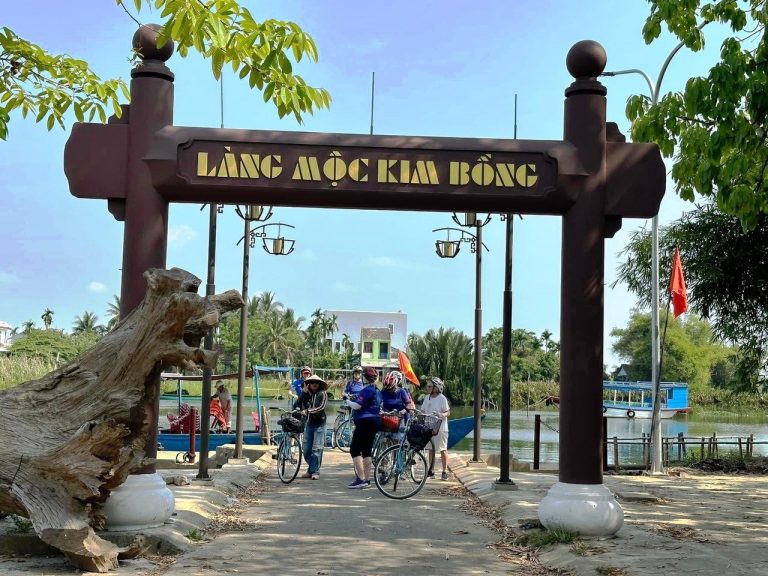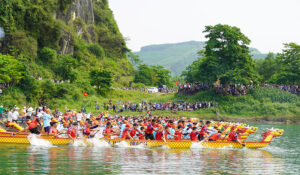Eight kilometres from the centre of Kon Tum city lies the Kon K’Tu eco-tourist village which attracts both domestic and foreign tourists keen to enjoy its unique culture and traditional long and stilt houses.
Kon K’Tu, which means "native village" in the Ba Na ethnic minority language, is the oldest village of the ethnic group to continue preserving the most original characteristics of the group’s culture.
From 1867-1869, about 100 houses made up the village, but an epidemic wiped out many of the villagers and left only three families alive. It wasn’t until 1920 that the village was re-established and thriving once again. Currently there are approximately 530 village residents, all from the Ba Na ethnic group.
Upon arrival in Kon K’Tu, the first image that amazes any visitor is the unique and primitive natural beauty. To the east lies the imposing Kong Muk Mountain, and a stunning sand bank stretches along the Dak Bla River.
Along a path to the ecological forest, tourists have a chance to take in the fresh air and the beautiful scenery of H’Lay and Map (Fat) Falls. Paddling along the peaceful Krong Bla River in rubber boats or dug-out canoes is another enjoyable activity.
Kon K’Tu also attracts visitors with its traditional long houses and houses on stilts.
"We are very proud of our traditional houses. They were designed by native Ba Na people a long time ago," says village patriarch A Xep.
Four to six kitchens serve the multiple generations of families that live together in each of the houses.
There is one door located at each end of traditional long houses, but the main door is located in front, right in the middle.
"It takes us nearly two weeks to cut down the trees and other plants required to build such special houses, which are warm in winter and cool in summer," says A Xep.
When night falls, visitors are captivated by wonderful tunes coming from the traditional gongs, which have been recognised as an intangible heritage of humanity by UNESCO, while enjoying the particular and delicious taste of ruou can (wine drunk out of a jar through pipes).
"What a wonderful piece of heaven! I love the unspoiled natural beauty and friendly people here. Even though I can not thoroughly understand all the traditional songs and dances, I still find them beautiful. I’ve also enjoyed watching the local children swim in the river and play on the sand," says 65-year-old American veteran James Michener.
Although many traditions have disappeared over time, the annual K’Lang T’nglang Festival is one of the rare celebrations that the Ba Na people have preserved.
The festival, its name meaning "to catch the water drop," is held on the first two days of every first lunar month.
On the first day, people prepare cay neu (New Year trees) to purge evil spirits. The next day, offerings of buffaloes, cows and gongs are made. Ba Na youth, in home-made tho cam (brocade) costumes, perform mua xoang, a traditional Ba Na dance, to express their wishes for favourable weather, abundant crops, health and solidarity.
"We are trying our best to preserve Ba Na’s cultural characteristics. Two groups for traditional performances continue to perform, including an 18-member gong group and a 30-member mua xoang team," says the village leader with happiness evident on his face.
About 10 years ago, Kon K’Tu began attracting tourists who wanted to experience its wild and unspoiled beauty. Construction of the Kon K’Lor suspension bridge in the 1990s made travel between Kon K’Tu and Kon Tum city more convenient.
Kon K’Tu receives 40-50 foreign visitors per day, proving its undeniable attraction to tourists, according to A Kheo, who has been the village leader for 35 years.
However, something saddens village patriarch A Xep. Ever since Kon K’Tu was turned into an eco-village and its road was upgraded, the lives of the people have improved while the original culture has been gradually lost. Communal houses, once unique tourist attractions, have been replaced by concrete versions.
A Xep’s eyes are full of intensity as he raises the difficult question: "Will the original culture of the village survive?"
Local authorities and visitors alike share his concern, both wondering what will happen to its unique characteristics and natural beauty if no preservation efforts are implemented.














